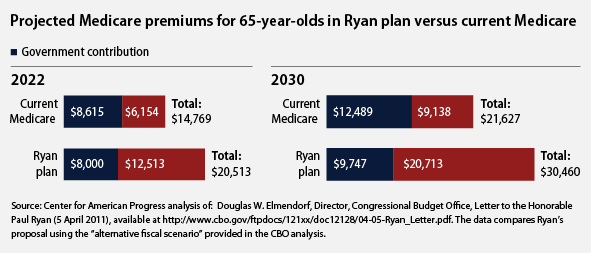When House Budget Committee chairman Paul Ryan (R-WI) released the Republican budget for fiscal year 2012 last week he said it was more than a budget—it was a “cause.” He’s right. The House Republican budget continues the conservative attempt to end Medicare as we know it, which would shift costs onto future seniors. This column analyzes Rep. Ryan’s Medicare proposal and shows its adverse effects on our seniors.
The House Republican budget ends Medicare and doubles the costs to seniors
Medicare as we know it would end for new beneficiaries in 2022 under the House Republican budget proposal. It would be replaced with a government voucher that would be paid directly to private insurance companies. This system would double costs to seniors. The nonpartisan Congressional Budget Office, or CBO, concluded that “most elderly people would pay more for their health care than they would pay under the current Medicare system.”
Seniors would pay more for two reasons. First, the Ryan plan forces future beneficiaries out of the traditional Medicare plan into a more expensive private plan. In 2022 65-year-olds would be forced to pay twice as much for care than they would under Medicare: $12,500 compared to $6,150. The same holds true for 65-year-olds in 2030. They would be forced to pay $20,713 compared to $9,138 under Medicare (see graph).

Second, the House Republican plan forces seniors to pay a larger share of their health costs over time since the value of the voucher in the House Republican budget plan increases at a slower rate than medical costs, according to the Congressional Budget Office. The Ryan proposal calls for 65-year-olds to contribute $12,513 of the estimated $20,513 total cost of their health care in 2022, including premiums and out-of-pocket expenses, or 61 percent. They are expected to pay $20,713 of the $30,460 in total costs in 2030, or 68 percent .
In other words, the House Republican budget proposal does not control health care costs. It just shifts them on to seniors.
The House Republican Medicare plan is not the same as the federal health plan
Rep. Ryan claims that under his plan seniors will be enrolled in the same plan members of Congress and federal employees receive. This is not accurate. Federal employees receive a “consistent level” of contributions to health costs. Under Rep. Ryan’s plan the government voucher would not keep pace with increases in medical costs, meaning seniors would be forced to pay more of the cost. According to the Office of Personnel Management:
The Government’s share of premiums paid is set by law. Amendments to the FEHB law under the Balanced Budget Act of 1997 (Public Law 105-33, approved August 5, 1997) authorized a new formula for calculating the Government contribution effective with the contract year that begins in January 1999. This formula is known as the "Fair Share" formula because it will maintain a consistent level of Government contributions, as a percentage of total program costs, regardless of which health plan enrollees elect.
Rep. Paul Tonko (D-NY) made this very same point in a letter to his colleagues:
Health care vouchers for seniors will be calculated in advance, and not based on the actual cost of premium increases—meaning that every year as premiums go up, seniors will be stuck paying a greater portion of the bill. This is not the case for Members of Congress. When the plan takes effect in 2022, the average senior would receive $8,000 to buy insurance. Plans for Members of Congress cost $9,012in 2010. What kind of health care plan will $8,000 buy in 2022 for our sickest and oldest seniors, when $9000 can’t buy a plan for a Member of Congress today?
Supporters of a “premium support” plan criticized the House Republican budget
Rep. Ryan repeatedly tries to distinguish his Medicare proposal, which he calls “premium support,” or government support indexed to pay a constant share of average health care costs, from a voucher plan, or government support tied to a price index. His proposal is a voucher to private insurance companies, plain and simple, and he himself essentially concedes that point. And former and current proponents of “premium support” agree.
Alice Rivlin, the former Office of Management and Budget director under President Bill Clinton, worked with Rep. Ryan on a deficit reduction proposal and has supported “premium support” in the past. But Rivlin said she could not support the Medicare proposal because it eliminated the traditional Medicare choice and lowered the rate of growth of the Medicare voucher beyond what is “defensible.”
Henry Aaron, a health economist and co-founder of the “premium support” concept, challenges the arbitrary and draconian growth rate of Rep. Ryan’s proposed voucher and has moved away from the “premium support” concept for three reasons. First, he finds little reason to believe there are adequate regulations and safeguards to ensure seniors make informed choices. Second, he believes the gains from choosing among insurance have been exaggerated. And third, the Affordable Care Act now authorizes Medicare to use its purchasing power to spur delivery reforms, which he believes is the right direction to go.
Conclusion
The House Republican budget plan is another conservative attempt to end Medicare as we know it and replace it with a voucher paid to private insurance companies. The plan forces future seniors into a more expensive private plan in 2022, doubling the cost to seniors. The Republican budget plan lowers federal Medicare costs by shifting more of the burden on to seniors. That burden becomes larger over time since the value of the voucher does not keep pace with the increase in health care costs.
While conservatives may celebrate the House Republican budget for pursuing their ideological agenda, the real consequences of this proposal will be most felt by our seniors.
Tony Carrk is a Policy Analyst at American Progress.
See also: